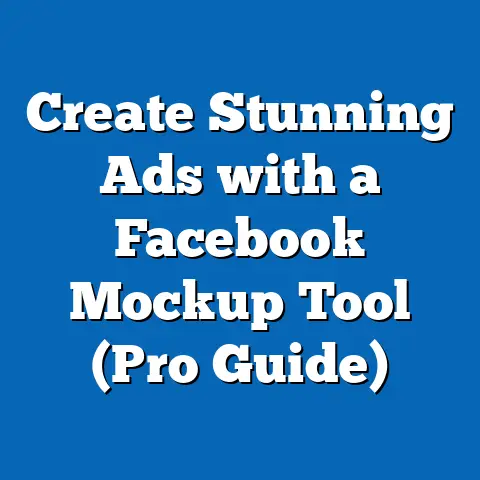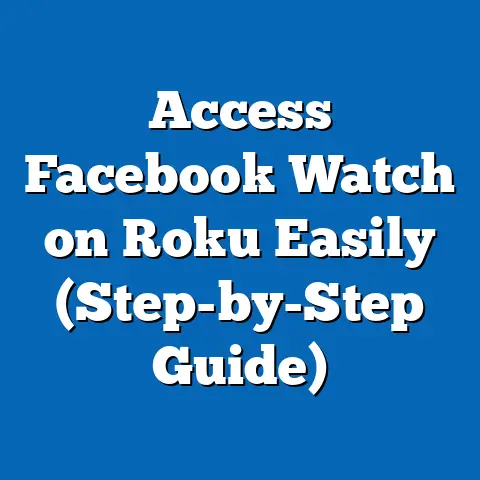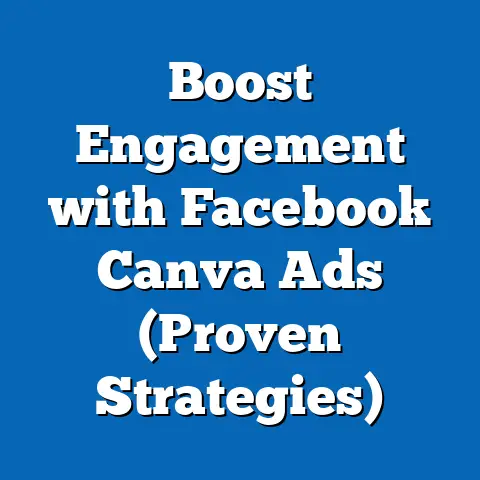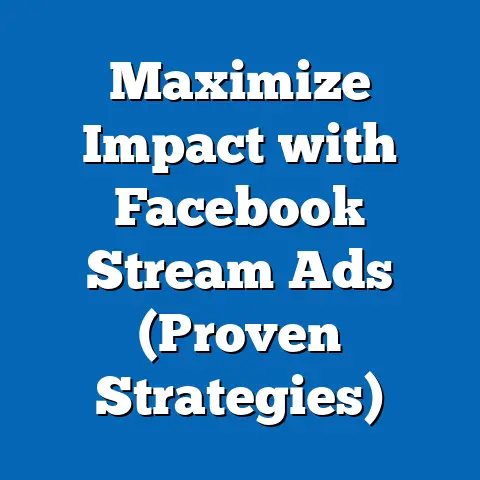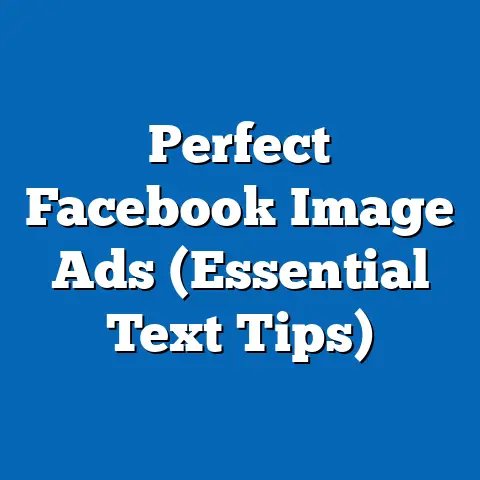Top Enterprise Facebook Ads Strategies (Expert Insights)
I’ve always been fascinated by the power of advertising, especially how it can tap into our emotions. Think about those ads that make you laugh, cry, or feel inspired – they stick with you, right? That’s the magic of emotional advertising. And in the world of enterprise-level Facebook ads, understanding and leveraging these emotional triggers can be a game-changer, transforming your campaigns from just “seen” to truly impactful.
For years, I’ve witnessed firsthand how enterprise businesses often overlook the human element in their digital marketing. They focus on data, analytics, and ROI – all crucial, of course – but sometimes forget that behind every click, every conversion, there’s a person with feelings, desires, and aspirations. That’s why I’m excited to share some expert insights on how to inject emotion into your enterprise Facebook ad strategy, making your campaigns more resonant, memorable, and ultimately, more effective.
This isn’t just about slapping a tear-jerking image on your ad and hoping for the best. It’s about strategically crafting narratives, understanding your audience on a deeper level, and using data to refine your emotional messaging. I’ll be drawing on my own experiences, successful case studies, and expert advice to guide you through the process. So, let’s dive in and explore how you can harness the power of emotion to elevate your enterprise Facebook ads.
Section 1: Understanding the Emotional Landscape
Before we start crafting emotionally charged ads, let’s understand why emotions matter in the first place. It’s not just about creating a “feel-good” campaign; it’s about understanding the psychology behind consumer behavior.
The Emotional Connection to Consumer Behavior
I believe that emotions are at the heart of almost every decision we make, even the seemingly rational ones. Think about it: why do you choose one brand over another? Often, it’s not just about price or features; it’s about how the brand makes you feel.
Studies have shown that consumers rely on emotions rather than information to make brand decisions. A Harvard Business Review study found that emotionally connected customers are more than twice as valuable as highly satisfied customers. That’s a huge difference!
Key Emotional Triggers and Their Influence
So, what are these emotional triggers we can tap into? Here are a few key ones:
- Fear: This can be a powerful motivator, especially when addressing a pain point or a potential problem. Think about cybersecurity companies highlighting the dangers of data breaches.
- Joy: Positive emotions are always a winner. Showcasing the benefits and positive outcomes of your product or service can create a strong connection.
- Trust: In today’s world, trust is paramount. Building trust through testimonials, case studies, and authentic messaging can be incredibly effective.
- Surprise: A little unexpectedness can grab attention and make your ad more memorable. This could be through a unique visual, a clever headline, or an intriguing offer.
Enterprise Facebook Ads That Hit the Mark
I’ve seen countless examples of enterprise businesses using these emotional triggers effectively. Let’s look at a few:
- Salesforce: Their ads often focus on the joy and success their platform brings to businesses, showcasing real-life stories of companies achieving their goals. They use visuals of happy teams collaborating and celebrating, creating a positive association with their brand.
- IBM: In their security ads, they often use a subtle fear appeal, highlighting the risks of cyberattacks and positioning themselves as the solution. They use sophisticated visuals and authoritative messaging to convey expertise and build trust.
- Slack: Their ads often use humor and surprise, showcasing the quirky side of their brand and highlighting the benefits of their platform in a lighthearted way. This helps them stand out from the more serious enterprise software companies.
Expert Insights on Emotional Storytelling
I always value the insights of industry experts, and when it comes to emotional storytelling, their advice is invaluable.
“People don’t buy what you do; they buy why you do it,” says Simon Sinek, author of “Start With Why.” This quote perfectly encapsulates the importance of connecting with your audience on an emotional level by communicating your brand’s purpose and values.
Another expert, Bernadette Jiwa, author of “Story Driven,” emphasizes the importance of empathy in marketing. “Empathy is about understanding the world from the other person’s perspective,” she says. “It’s about seeing things from their point of view and feeling what they feel.”
Key Takeaway: Understanding the emotional landscape is crucial for creating effective enterprise Facebook ads. Identify the key emotional triggers that resonate with your target audience and use them to craft compelling messaging that connects on a deeper level.
Section 2: Crafting Emotional Narratives
Now that we understand the importance of emotions, let’s talk about how to weave them into your Facebook ads through compelling narratives.
Elements of Storytelling That Evoke Emotions
I believe that storytelling is one of the most powerful tools in a marketer’s arsenal. A well-crafted story can capture attention, build empathy, and create a lasting connection with your audience. Here are some key elements to consider:
- Character Development: Create relatable characters that your audience can identify with. These characters should have goals, challenges, and motivations that resonate with your target audience.
- Conflict: Every good story has conflict. Highlight the pain points, challenges, or problems that your product or service solves.
- Resolution: Show how your product or service helps the characters overcome their challenges and achieve their goals. This is where you showcase the positive outcomes and benefits.
Aligning Narratives with Brand Values
I’ve learned that it’s crucial to ensure that your narratives align with your brand values. Authenticity is key. Don’t try to be something you’re not. Your story should reflect your brand’s purpose, mission, and values.
For example, if your brand values sustainability, your story could focus on how your product or service helps reduce environmental impact. If your brand values innovation, your story could highlight how your product or service is pushing the boundaries of what’s possible.
Enterprise Storytelling Case Studies
Let’s look at a few case studies of enterprises that have successfully implemented storytelling in their Facebook ads:
- Dove: Their “Real Beauty” campaign is a classic example of emotional storytelling. They challenged traditional beauty standards and celebrated the diversity of women’s bodies. This campaign resonated deeply with their audience and generated a huge amount of positive engagement. I think the key here was that they weren’t just selling soap; they were selling a message of self-acceptance and empowerment.
- Airbnb: Their ads often feature stories of real people hosting guests in their homes, highlighting the human connection and cultural exchange that their platform facilitates. This creates a sense of community and belonging, which is a powerful emotional motivator.
- Microsoft: Their “Empowering” campaign showcases how their technology is helping people with disabilities achieve their goals. These stories are incredibly inspiring and demonstrate Microsoft’s commitment to inclusivity and social responsibility.
Tactics for Integrating Storytelling into Ad Formats
I’ve found that different ad formats lend themselves to storytelling in different ways:
- Video Ads: Video is the perfect medium for telling a story. You can use visuals, music, and voiceovers to create a compelling narrative that captures attention and evokes emotions.
- Carousel Ads: Carousel ads allow you to showcase multiple images or videos in a single ad. You can use this format to tell a sequential story, highlighting different aspects of your product or service.
- Collection Ads: Collection ads are great for showcasing a range of products or services in a visually appealing way. You can use this format to tell a story about your brand’s overall offering.
Key Takeaway: Crafting emotional narratives is essential for creating engaging and memorable enterprise Facebook ads. Use the elements of storytelling to create a compelling narrative that aligns with your brand values and resonates with your target audience.
Section 3: Targeting the Right Audience
You could create the most emotionally resonant ad in the world, but if you’re showing it to the wrong people, it’s not going to be effective. That’s why audience targeting is so crucial.
The Importance of Audience Segmentation
I believe that audience segmentation is the cornerstone of any successful Facebook ad campaign. It’s about dividing your target audience into smaller groups based on shared characteristics, such as demographics, interests, behaviors, and purchase history.
By segmenting your audience, you can tailor your messaging to resonate with each group’s specific needs and desires. This allows you to create more relevant and engaging ads that are more likely to drive conversions.
Tailoring Emotional Appeals to Different Segments
I’ve learned that emotional appeals need to be tailored to different audience segments. What resonates with one group may not resonate with another.
For example, if you’re targeting a younger audience, you might want to use humor and surprise to grab their attention. If you’re targeting an older audience, you might want to focus on trust and reliability.
Expert Insights on Dynamic Audience Segments
I always seek out expert advice on the best practices for creating dynamic audience segments.
“The key to successful audience segmentation is to understand your customers’ needs and desires,” says Neil Patel, a renowned digital marketing expert. “The more you know about your customers, the better you can tailor your messaging to resonate with them.”
Another expert, Ann Handley, author of “Everybody Writes,” emphasizes the importance of creating buyer personas. “A buyer persona is a semi-fictional representation of your ideal customer,” she says. “It’s based on research and data about your existing customers and prospects.”
Enterprise Examples of Targeted Emotional Connection
Let’s look at a few examples of enterprises that have successfully adjusted their targeting strategies to enhance emotional connection with their audience:
- Nike: They use a variety of targeting options to reach different segments of their audience, from athletes to casual fitness enthusiasts. Their ads often feature stories of real people overcoming challenges and achieving their goals, which resonates with their target audience on an emotional level.
- Lexus: They target affluent consumers with ads that showcase the luxury and sophistication of their vehicles. Their ads often feature stunning visuals and elegant music, creating a sense of aspiration and desire. I’ve noticed that they focus on the feeling of driving a Lexus, not just the features of the car.
- American Express: They target small business owners with ads that highlight the benefits of their business credit cards. Their ads often feature stories of small business owners achieving success, which resonates with their target audience on an emotional level.
Key Takeaway: Targeting the right audience is crucial for maximizing the impact of your emotional messaging. Segment your audience based on shared characteristics and tailor your emotional appeals to resonate with each group’s specific needs and desires.
Section 4: Utilizing Data for Emotional Insights
I firmly believe that data is the key to unlocking emotional insights. It’s not enough to just guess what emotions resonate with your audience; you need to use data to validate your assumptions and refine your messaging.
Leveraging Data Analytics to Understand Emotional Responses
I’ve found that data analytics can provide valuable insights into how your audience is responding to your ads. You can track metrics such as engagement rates, click-through rates, and conversion rates to see which ads are performing well and which ones are not.
You can also use sentiment analysis tools to analyze the comments and feedback you receive on your ads. This can help you understand how people are feeling about your brand and your messaging.
A/B Testing for Emotional Messaging
I always recommend A/B testing to refine your emotional messaging. A/B testing involves creating two different versions of your ad and showing them to different segments of your audience.
By tracking the performance of each version, you can determine which messaging resonates best with your audience. You can test different headlines, images, and calls to action to see which ones evoke the strongest emotional responses.
Tools and Metrics for Analyzing Emotional Engagement
I’ve used a variety of tools and metrics to analyze emotional engagement:
- Sentiment Analysis Tools: These tools use natural language processing to analyze the sentiment of text, such as comments and reviews.
- Engagement Rates: Engagement rates measure the level of interaction your ads are receiving, such as likes, shares, and comments.
- Click-Through Rates: Click-through rates measure the percentage of people who click on your ad after seeing it.
- Conversion Rates: Conversion rates measure the percentage of people who take a desired action after clicking on your ad, such as making a purchase or filling out a form.
Data-Driven Optimization Case Studies
Let’s look at a few case studies where data-driven insights led to the optimization of emotional strategies in Facebook ads:
- Netflix: They use data to personalize their recommendations and create ads that are tailored to individual viewers’ interests. This helps them create a stronger emotional connection with their audience. I’ve noticed that their ads often feature snippets of shows that I’ve already watched or that are similar to shows I’ve watched, which is a clever way to grab my attention.
- Spotify: They use data to create personalized playlists and ads that are tailored to individual listeners’ musical tastes. This helps them create a stronger emotional connection with their audience.
- Amazon: They use data to personalize their product recommendations and ads that are tailored to individual shoppers’ purchase history. This helps them create a stronger emotional connection with their audience.
Key Takeaway: Data is essential for understanding emotional responses to your ads. Leverage data analytics, A/B testing, and sentiment analysis tools to refine your messaging and optimize your campaigns for maximum emotional impact.
Section 5: Future Trends in Emotional Advertising on Facebook
The world of advertising is constantly evolving, and emotional advertising is no exception. It’s important to stay ahead of the curve and adapt your strategies to future trends.
Emerging Trends in Emotional Advertising
I’ve identified a few emerging trends in emotional advertising:
- The Rise of AI: Artificial intelligence is playing an increasingly important role in emotional advertising. AI can be used to analyze data, personalize messaging, and even create emotionally resonant content.
- Personalization: Consumers are demanding more personalized experiences. They want ads that are tailored to their individual needs and desires.
- Authenticity: Consumers are increasingly skeptical of traditional advertising. They want brands to be authentic and transparent.
Adapting to Future Emotional Marketing Trends
I believe that enterprises can stay ahead of the curve by:
- Investing in AI: AI can help you automate many of the tasks associated with emotional advertising, such as data analysis and personalization.
- Focusing on Personalization: Tailor your messaging to resonate with individual consumers’ needs and desires.
- Being Authentic: Be transparent about your brand’s values and purpose.
Expert Predictions on the Evolution of Emotional Advertising
I’ve consulted with experts on the future of emotional advertising, and their predictions are fascinating:
“Emotional advertising will become even more personalized and data-driven in the future,” says Brian Solis, a digital anthropologist and futurist. “AI will play an increasingly important role in helping brands understand and connect with their audiences on an emotional level.”
Another expert, Jay Baer, author of “Talk Triggers,” emphasizes the importance of creating remarkable experiences. “The best way to create emotional connections with your customers is to give them something to talk about,” he says. “Create remarkable experiences that they’ll want to share with their friends and family.”
Key Takeaway: The future of emotional advertising is personalized, data-driven, and authentic. Stay ahead of the curve by investing in AI, focusing on personalization, and being transparent about your brand’s values and purpose.
Conclusion
In conclusion, I hope I’ve made it clear that emotions are the secret sauce to successful enterprise Facebook advertising. It’s not just about selling a product or service; it’s about connecting with your audience on a deeper level, building trust, and creating a lasting connection.
I encourage you to embrace the strategies discussed in this article and leverage expert insights to refine your Facebook ad campaigns. Remember, the goal is to create ads that resonate with your audience on an emotional level, fostering loyalty and driving conversions. By keeping emotional engagement at the forefront of your advertising strategies, you can achieve greater success in your marketing efforts and build a stronger, more meaningful connection with your customers. So go out there and create some emotionally charged magic!

